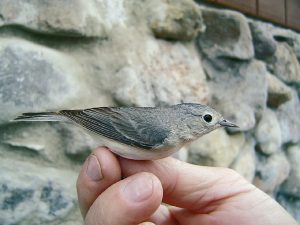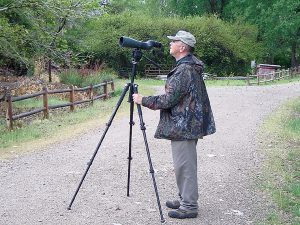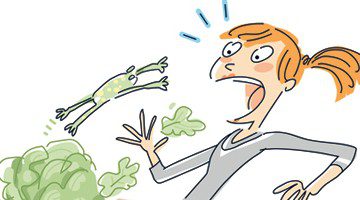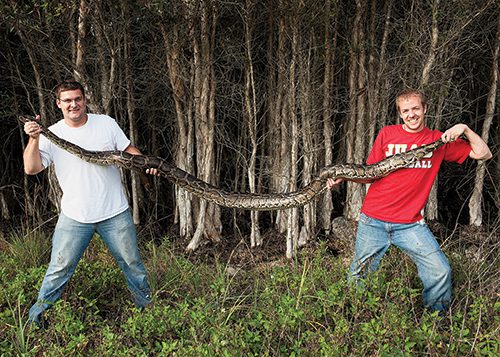
A Lucy’s warbler perches on Hal Black’s hand, giving students an up-close view of the sub-5-inch bird. Photo by Jaren Auger.
Rattling over the backroads of west Springville with a vanload of Integrative Biology 134 students, zoology professor Hal L. Black sounds the alarm: “There’s a meadowlark!”
As the class flies down the road, what Black sees is more like a distant yellow blur perched on a fence post near a field of grazing cattle. But it’s no big surprise that, when the van slows to a halt and the students train their binoculars, a sharp-billed bird with a bright yellow breast comes into focus: a western meadowlark, of course.
Quick to shrug off any suggestion of superhuman vision, Black says he’s working more from experience. “You know that this time of year you can expect to see meadowlarks sitting on fence posts. The kids say, ‘How do you know what it is?’ Well, it can’t be anything else.”
Black knows that most of the students in InBio 134—better known as Appreciation of Nature—have spent their whole lives seeing birds without really seeing them. But with the goal of turning undergraduates into lifelong nature lovers, he hands out the class’s backbone assignment: identifying 75 species of birds during the semester.

Bird aficionado Hal Black peers through his spotting scope during a record three-day bird-watching field trip with his students. Photo by Jaren Auger.
Why birds? To Black, their omnipresence—not to mention their amazing colors and flight patterns—makes them an obvious choice. “If you have students in a biology class and it’s a one-shot affair, and you think, What can I give them that will be biology or natural history for life? you just have to pick on birds.”
To keep birds on the brain in class, he blasts Puccini’s “Nessun Dorma,” emphasizing a common human/avian love of singing, and has students brainstorm birds in pop culture (quick answers include the Seattle Seahawks and Sesame Street‘s Big Bird).
He and a teaching assistant also organize field trips to wildlife-rich areas like Diamond Fork Canyon or the shores of Utah Lake, where novice birders can bag 25 different species in a single outing. Still, most students don’t have to go that far before a sense of wonder sets in. “I remember a couple of students almost passed out when they saw a western tanager on campus, with those incredibly bright colors,” Black laughs. “It’s like, ‘This must have escaped from the zoo or something.'”
Ultimately, he hopes that a love of birding remains with students after the final exam and that it has some trickle-down effects. “If someone loves the marsh for birds and then someone talks about draining the marsh, well, they might be upset because they know what the marsh means for bird life,” says Black. “We think that if they learn to appreciate and love some piece of nature, it will transfer to nature in general.”
For Camie Frandsen, ’06, that’s proved true. She switched her major to conservation biology after taking the class and says it has made her value the little things in life. “Now if I go walking and I see a new bird, I’ll be excited all day.”









